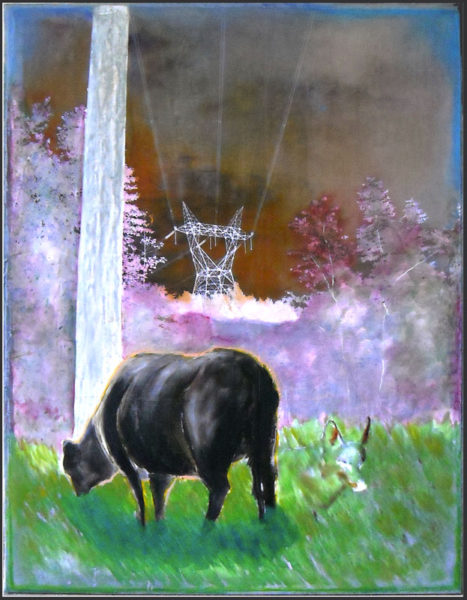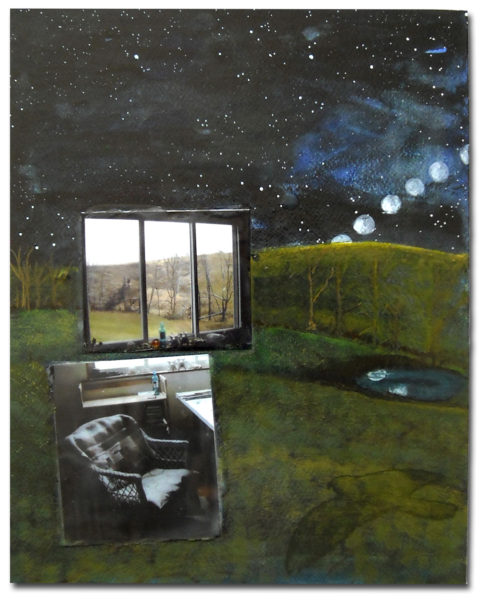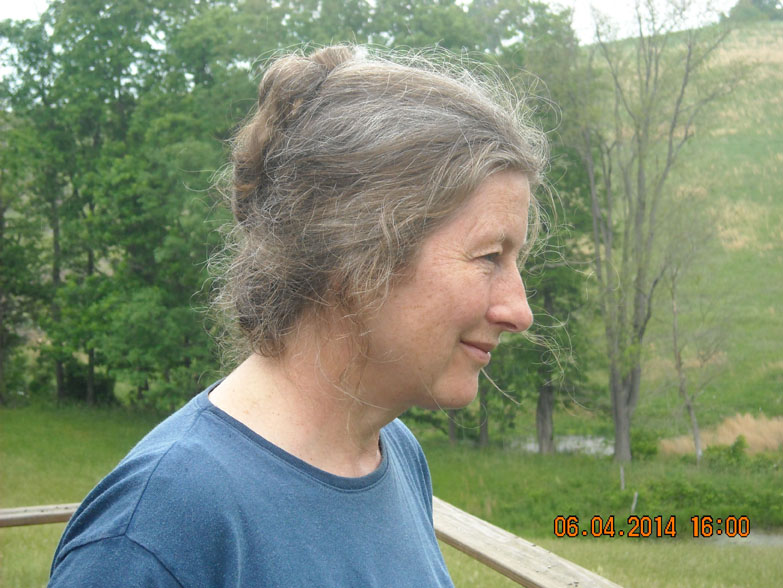Elizabeth Jaeger exhibits her solo show, Inside Looking Out, at Monongalia Arts Center, 120 High Street in Morgantown, through April 1st. The changes wrought by larger scale strip mining that came to her neighborhood in 2007 became the subject for many of the images, as well as the impact of power lines and three coal-fired power plants in the area. The title refers to the twelve windows of her house, which are the basis for many of the works; the blending of interior space into exterior space. Contrasting ‘day and night’, ‘photographic and painted’ , ‘positive and negative’ or ‘inside and outside’ provides a way to see how strip mining has impacted her corner of western Monongalia County. She shares with Zackquill about how she came to West Virginia, how this exhibit came about, her favorite thing about being an artist here and much more…
Z: How did you end up in West Virginia?
E: I came to West Virginia in 1976 because it was the only graduate MFA program that accepted me. I came from north central Illinois via University of Notre Dame. I stayed here because I met my husband, who arrived the following year to teach sculpture.
Z: How did you come to be an artist?
E: I always loved art. My mom was an artist and my art teacher in school. When she hung Van Gogh and Gauguin reproductions on the wall, they really knocked me out. I thought it would be so great to be able to paint like that too. The color went right through me.
Z: How did this exhibition come about? Why is this important for the Morgantown community?
E: This exhibition grew from my photo documentation of the changes that descended on my neighborhood with the selling out to strip mining. There has always been coal removal in my neighborhood of Sugar Grove, west of Morgantown, West Virginia. In the old days most houses near an exposed coal seam would dig their own coal for personal use from what was called a kitchen or punch mine. Some of these portals are still visible.
As machinery became more powerful, strip mining, or the removal of ground to expose a large swath of a coal seam, became possible. When we built a house in Sugar Grove in 1978, there were a few small strip mines around. Slowly they became bigger and the blasts to remove the ‘overburden’ more powerful. Interesting that the very ground on which people lived was described as a burden. Our neighbors were mostly farmers who kept cows to breed calves to send to feedlots. We never kept animals ourselves but were glad to let a neighbor take hay off our pasture for his cows. Before 2007, a farmer named John Bucy, who refused to sell his coal seam to stripping companies, died and his sons who lived far away sold the land to a local lawyer, who soon had it stripped. The first Bucy mine, a most inappropriate name, began in February of 2007 on Sugar Grove Road. I have walked Sugar Grove Road most days since 2003 and as the small hill farms gave way to strip mines, I carried my camera to document the changes. In 2010, a big power line was routed through our neighborhood using eminent domain. People forced to have the big pylons on their land decided to sell out to stripping companies as well. Soon, Bucy #2 Mine (S-2008-09) was underway, whose progress along Sugar Grove Road I photographed daily. In 2011 we received a letter from the stripping company asking us to come see them to ‘discuss business’. That was a dark day indeed because it meant neighbors close to us had already agreed to a stripping contract. We ignored the letter. The permit process for Bucy #3 Mine (S-2002-12) moved forward, despite our attempts to stop the permit. As West Virginia gets much of its revenue from coal severance taxes, the WV Department of Environmental Protection rarely turns down a permit application. So our attempts to stop another strip mine in a residential area went nowhere.

In August of 2012, the strip mine, whose boundary would come up to our fence line, got underway. We bought a movie camera to document the blasts, dust and noise from the heavy machinery that often began at 5 am and went on until midnight. I collected a lot of images. Apparently all the residents of the area just had to tolerate the cracked walls, noise and dust so that a handful of people could make money. In May of 2014, the stripping company declared bankruptcy, having made their money, and skipped out on their debts to their employees and subcontractors. The insufficient bond money posted to cover the reclamation was forfeited and the state of WV is left to clean up the abandoned mines. But West Virginia now has no money so reclamation may never happen. Much of the art work presented here grew from the photos I took of the changes in my neighborhood. Unlike words, images are understandable by everyone across time, space and culture, which is why we can look at Paleolithic cave paintings and know the ‘what’, if not the ‘why’. Looking for poetic meaning in my domestic space is another reason to make the images. But my images are also aimed at people of the future, to apologize for our collective squandering and destruction of their world.
The artwork presented here is about a particular time and place: the peripheral areas of Morgantown, West Virginia in the early 21st Century, a period of significant change from coal as king to coal as history. It will not be easy for the state to create a new revenue source and especially a new identity. But the state mascot is a mountaineer, not a coal miner so perhaps we should return to the original mountain identity but with a 21st Century awareness. My artwork is intimate and domestic. I think of it as a diary of the time I have lived here – a small sliver of the long history of this corner of Appalachia. It is set against the backdrop of the universe as seen in the many starry skies in my paintings.
Enlightenment might be the ability to see the world from outside one’s own head, window or house – to see the larger picture – indeed, to see how the whole picture fits together and how interwoven each element is with every other element. May our human arrogance not prevent the enlightenment of seeing ourselves as a very small piece of the outside world’s puzzle.

It is important for Morgantown because I doubt few people who work at the university and rarely drive out west of town – the poor side of town – would have any idea how much strip mining there is here and what effect it has on the people who live near it. Most of the land west and north of Morgantown has been stripped at some point. Most of it is not visible from the roads.
Z: How do you think the environment is for the arts in Morgantown? How do you think it could improve?
E: It amazes me how few galleries there are in a town with so many educated people. The university has its new museum, which seems to be doing a better job than the CAC of connecting to the rest of Morgantown. Art is best seen in a clean, simple space with no windows and good track lights. MAC is the most viable space to show art because it looks most like a real art gallery. MAC does a reasonable job and I appreciate its openness to social and environmental issues.
Z: What is your favorite thing about being an artist/creative/curator in Morgantown?
E: The best thing about being an artist here is that the cost of living is low so that we don’t have to generate much money to survive, leaving us more time to be artists. In New York we would have to work day and night just to pay the rent. The flip side of that is that being an artist in Morgantown means having to be entirely self-motivated because there is not a big and stimulating artistic community. But that can be a good thing. Since my husband is an artist, we use each other for input. And we get to big city art museums a few times a year, which aren’t too far away from here.
Z: What would people be surprised to know about you?
E: I can’t think of anything about me that would surprise anyone. All my friends know that I talk to birds when out walking and rescue stink bugs from the bathtub before showering.
For more information on Elizabeth Jaeger’s exhibit, visit Monongalia Arts Center, 120 High Street, or http://www.monartscenter.com/.
–
Sally Deskins is an artist, writer and curator based in Morgantown. She co-curated the exhibit IN.EXclusive: an exhibit and event series dedicated to women in West Virginia, at Arts Mon, 201 High Street, through March 25; and BARED: the art of bras and breasts, at The Diamond Shop Gallery, 320 High Street, through March 24.

